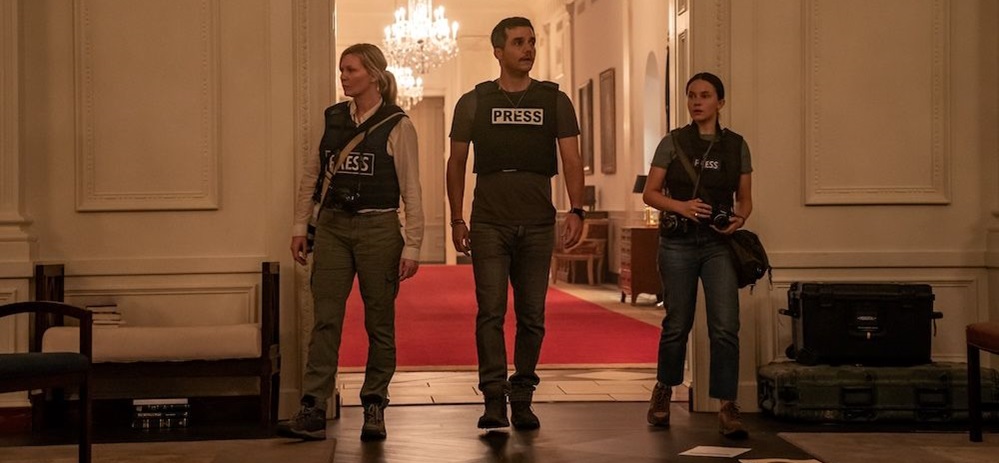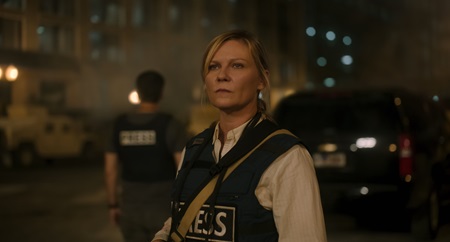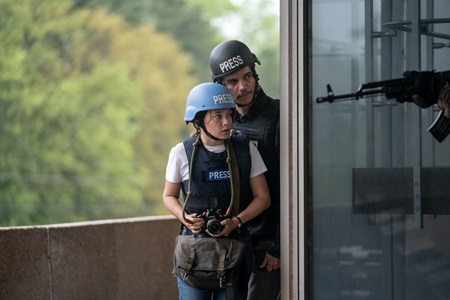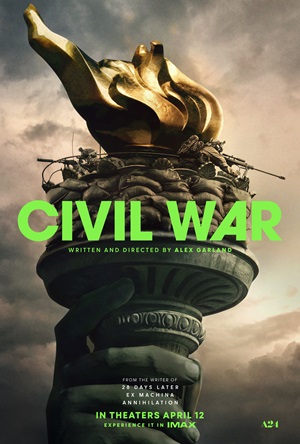
Technically Precise Journalistic Procedural Civil War Shoots too many Narrative Blanks
For those who end up having significant issues with the film Civil War, I imagine the big consensus complaint about it is that English writer-director Alex Garland (Ex Machina, Annihilation) does not explain what the catalyst was that led to California, Texas, and Florida declaring war on the president of the United States (Nick Offerman). It is never said that the three states officially seceded from the Union. It is never mentioned that they are trying to set up their own governments. Garland refuses to even hint at what sparked the conflict or what it is they are fighting to achieve (other than the death of the president), but it is a violent insurrection nonetheless.
Instead, the filmmaker takes a more procedural approach to his scenario, similar to how Hollywood filmmakers have tackled conflicts abroad for decades, at least from the American point of view. Roger Spottiswoode’s 1983 classic Under Fire comes to mind. Like that blistering thriller (which chronicled the last days of the Somoza regime in Nicaragua in 1979), Garland chooses to see events through the eyes of a quartet of journalists, including two photographers, and in doing so crafts a drama free of political leaning and built on a foundation of nonbiased, observational distancing.
I do get why he does this. From a purely superficial standpoint, if Garland tried to give a reason why California, Texas, and Florida were all in cahoots, anything the filmmaker came up with — no matter how plausible or fun to posit — would end up being unintentionally laughable to domestic audiences. With things being how they are as of April 2024, it makes no logical sense that those three states would form an alliance, and few would buy it.
The more logical reason that Garland decided to keep the backstory indistinct is that he knows how doing this would put viewers on edge — not just those in the United States but all over the world. As polarized as this country may be right now, viewers are not used to seeing such a realistic dystopia. Garland treats the United States the same way Spottiswoode looked at Nicaragua, Peter Weir wrestled with Indonesia in The Year of Living Dangerously, and Denis Villeneuve dove into the Middle East crisis with Incendies, so those expecting something like The Purge are in for a shock.
Here’s the thing: I don’t think this drama has anything interesting outside of the obvious to say. Unlike Spottiswoode, Villeneuve, and especially Weir, I didn’t find Garland’s musings to be particularly profound. The greater point seems to be something along the lines of “war bad” and that anyone who comes in contact with it, assuming they survive, will be forever changed. Oh, sure, there’s something of an ethical discussion on how journalists cover these events (especially photojournalists), but even that analysis doesn’t dig underneath the surface, and, because of this, I never developed a lasting emotional attachment to what was going on.
Civil War still drew me in though. Most of this is due to Garland’s cinema verité approach. This documentary style is reminiscent of several real-life procedurals, most notably Michael Winterbottom’s 1997 drama Welcome to Sarajevo. It has a you-are-there feel that’s immediate and visceral. Garland drops the viewer squarely in the middle of the meat grinder, starting events off with a water riot on the streets of New York that quickly transforms into a hellacious suicide bombing. It’s jarring.
It’s here where the film introduces celebrated photojournalist Lee (Kirsten Dunst) and veteran war reporter Joel (Wagner Moura), who are planning on making the dangerous drive to Washington, DC in hopes of scoring an interview with the president. They are joined on the trek by their mentor, revered New York Times journalist Sammy (Stephen McKinley Henderson), and while he doesn’t approve of their plan, he’ll go along with them at least as far as Charlottesville. Young upstart Jessie (Cailee Spaeny), who looks up to Lee, manages to talk her way into the news van as well.
What happens next is your basic war-is-hell travelogue. Each point on the map tests the quartet’s objectivity, and this includes one pit stop in a small Southern town where the citizens have seemingly made the collective decision to act like everything is normal and that neighbor isn’t out there shooting neighbor (just don’t look too closely at the rooftops). While the group faces several perilous encounters, the most lethal of these turns out to be a trio of soldiers led by a scene-stealing Jesse Plemons. Have the journalists stumbled into a war crime? If they have, what are the chances those responsible for carrying it out will let the four get back on the road, knowing they’ll likely report what it is they’ve seen?
Garland’s use of sound is exquisite, and the lush, chillingly immersive camerawork composed by director of photography Rob Hardy (Mission: Impossible – Fallout) makes superb use of the gigantic IMAX frame. Editor Jake Roberts brings the same tension-filled attention to detail he did to his Academy Award–nominated work on 2017’s Hell or High Water, and there was never a moment when I felt a scene overstayed its welcome.
Best of all is Dunst. She’s spectacular. Her performance has a world-weary tenacity that’s intoxicating. Dunst does things with her body movements that continually fascinated me, and her penetrating glare felt like a punch to the gut. While Garland’s script resists fleshing Lee out, the actor picks up the slack and does all the heavy lifting herself. The photojournalist’s backstory, as purposefully obtuse as it may be, is still chillingly clear, Dunst is the mesmerizing glue that keeps all the pieces linked together, no matter how ill-fitting.
Unfortunately, I think that the director lets his characters down, especially the women. Lee deserves better than what Garland does with her, and Jessie’s transformation into a “real” photojournalist is so one-dimensional, it’s almost insulting. There is a matter-of-fact obviousness to where developments end up that did not work for me, with Garland treating these two as if their interior lives were a waste of time that no one in the audience would be interested in exploring.
Though numerous aspects of the production are laudable, Garland’s Civil War remains a vexing mixed bag. The film is almost too observational, and its ambiguity is frustrating. If it is a treatise on journalistic ethics, then the siege of Washington, DC in the finale is so bludgeoning and didactic that whatever Garland wanted to say is lost in all the Sturm und Drang. If there are any overarching political points the filmmaker is reaching for — and I do not think that there are — they’re so vague, they might as well be invisible. As narrative conflicts go, this one shoots too many blanks to be effective.
– Review reprinted courtesy of the SGN in Seattle
Film Rating: 2½ (out of 4)








